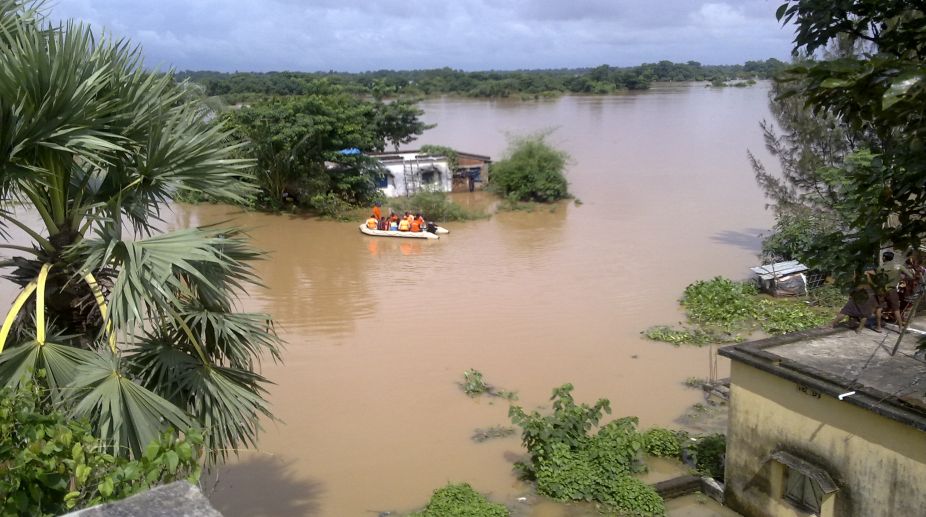70.77 % polling in Assam in first phase of LS polls
Notably, Jorhat saw the highest turnout, reaching 76.20% by 3 pm.

Harkanta Barman grew up at a remote village called Bhojkuji in Nalbari district of western Assam and like many others faced the fury of floods.
Every monsoon the swollen Pagladiya River destroyed crops in his village. The eldest son in a poor farmer's family, Harkanta went to school and also helped his family in the field. His ambition was to become a teacher. But perennial floods had already crippled the family and finally his father sent him to Guwahati to learn carpentry. Today he is a seasoned carpenter, married and lives in Guwahati.
One can find thousands of young men like Harkanta in rural Assam whose dreams were washed away by floods of different tributaries of the Brahmaputra.
Advertisement
With the onset of the monsoon this year, the first flush of floods has already affected thousands of families in various villages of the Brahmaputra and Barak valleys.
The state recorded excessive rainfall in the first half of June creating havoc in Guwahati and has claimed six lives so far. According to the Assam State Disaster Management Authority, the first wave of floods affected over 100,000 people in six districts.
Heavy loss of crops was also reported as 385.67 hectares were inundated. The district administrations have already opened relief camps where hundreds of families are taking shelter.
The government recently published a report that was prepared with the help of the All India Disaster Management Institute. It pointed that city flash floods were mostly man-made and said that inefficient drainage system, rotting solid wastes and reclamation of low-lying land were the cause for devastating city flash floods. The cutting down of hills to make room for rapid urban growth is a major cause for concern.
The report continued that “Guwahati city, on the south bank of the Brahmaputra is sitting in the midst of natural wetlands, forests, hillocks and on the edge of one of the mightiest rivers in the world. All these constitute an interlinked ecological system, which is under threat due to rapid and unplanned development.
“Environmental degradation is fast becoming a major threat to this sensitive arrangement of natural entities. Encroachment on wetlands that served as natural reservoirs has reduced the retention capacity of the drainage system, causing the flood level to rise. Those who have come to the city for a better life have occupied important places in hill areas posing major threats to flood mitigating initiatives.
“Statistics reveal that the Brahmaputra valley is one of the most hazard-prone regions in the country. The government has set up various flood management bodies like Central Water Commission (1945), Ganga Flood Control Mission (1972), Brahmaputra Board (1980) etc, but these have hardly succeeded in controlling and mitigating the annual flood in the country.
Even the proposed floodwarning system has remained a nonstarter.” It may be noted that the embankments along the Brahmaputra and its more than 50 tributaries were constructed 70 years ago. Successive governments miserably failed to maintain these. No alternate measures to face the monsoon floods were taken up even though every political party mentioned about flood mitigation in their poll manifestos.
In a recent directive, Assam chief minister Sarbananda Sonowal asked all responsible officers of the water resources department to take note of repairing works of embankments and ordered that they be completed at the earliest. The government had already released Rs 347 crore for the purpose.
The chief minister recently met Brahmaputra Board officials in New Delhi and pointed out that in the absence of responsible officials in the field, the embankment-protection and anti-erosion works had been severely affected. The chief minister wants a permanent office established in the river island and has said that the inhabitants of Majuli were not happy with the board's activities.
Responding to his views, the board has announced to spend Rs 207 crore for protection of the river island. Once identified as the largest river island in the world with a land area of 1,265 square kilometre, Majuli today spans only 525 sq km. Even so Majuli still remains the epicentre of Vaishnavite culture, inspiring the Assamese community for centuries.
The Assam government is also planning to undertake dredging of the Brahmaputra. After meeting Union minister Nitin Gadkari in Delhi recently, Sonowal said the Centre was responding positively to the proposal. The successful dredging of the Brahmaputra is expected to give people relief from the perennial problem of floods and erosion, commented Sonowal on 23 March this year.
The primary concern of the first time BJP government at Dispur is the well-being of the people of Guwahati, which is becoming the virtual capital of North-east India.
A portfolio called Guwahati Development has also been created to look into the city's problems. With the objective of making Guwahati a flash flood-free city, the state minister concerned, Himanta Biswa Sarma has taken a few initiatives. But he too feels that it would be a herculean job and the government needs a few more years to achieve the goal. He was supported by the BJP lawmaker from the city, Bijaya Chakrabarty, who recently said in public that a flood- free Guwahati would remain a distant dream for some time.
Even after all negative parameters — truly unchallenged by the campaigning of the ruling political class for changes (paribartan) — Harkanta does not want to leave the city and go back to his ancestral village.
Rather, the hard working carpenter today pursues his new dream of making his only daughter a collector and for that he is prepared to stay in Guwahati as a tenant in a clumsy locality.
The writer is the Guwahati-based special representative of The Statesman
Advertisement